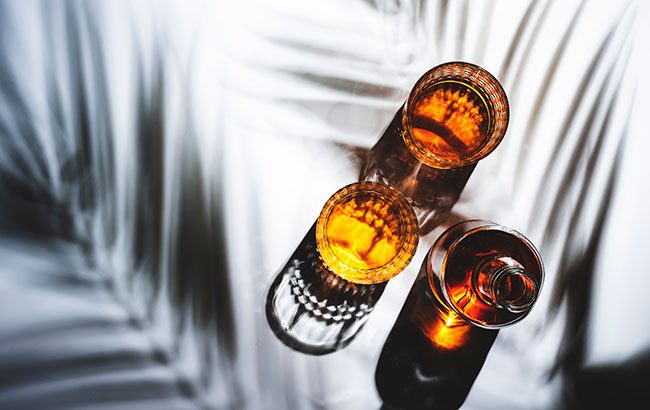Global spirits volume rises 5% in 2022
The global spirits category increased by 5% in volume last year, led by whisky and rum, according to data from IWSR Drinks Market Analysis.

Globally, spirits declined by 2% in volume in 2022, mainly due to low-priced baijiu in China, the IWSR said.
However, excluding local spirits such as Chinese baijiu, Korean soju, Japanese shochu, and arrack, the global spirits sector rose by 5% last year.
The spirits sector is expected to report a 0.5% volume increase from 2022 to 2027.
Spirits growth was driven by volume gains last year for whisky (up 8%), rum (up 9%) and brandy (up 6%).
Cognac struggled globally, dropping by 10% in volume last year due to declines in its key markets, the US and China.
Rum and brandy are each expected to report a 2% volume CAGR rise over the next five years, while Cognac and whisky are forecast to post a 3% increase.
Globally, gin volume grew by 8% last year and is predicted to increase by 3% over the next five years.
But the category is now in a ‘long-term decline’ in the UK (down 12% last year) and is predicted to drop by 6% in the market from 2022 to 2027.
Gin has also ‘lost momentum’ in many growth markets such as Brazil, South Africa, and Australia.
Premiumisation will be one of the key growth drivers for spirits, the IWSR said.
The premium-plus whisky segment is expected to rise by 4% in volume (CAGR 2022-2027).
The IWSR highlighted a move towards ‘significant up-trading’ in India for both Indian whisky and Scotch. Sales of premium Indian whisky in the market are expected to grow six-fold between 2019 and 2027.
In the US, whisky grew by 2% in volume last year, driven by premium-and-above segments, which are expected to increase by 4% (CAGR 2022-2017).
Agave spirits boom
Globally, agave-based spirits climbed by 13% in 2022, led by the US (up 12% last year). The category is predicted to rise by 9% in volume in the States in the five years to 2027.
Tequila is set to overtake vodka in 2023, the IWSR reiterated, however the analyst noted ‘early signs of slowdown in the premiumisation trend’.
Meanwhile, alternative agave spirits are also poised for further growth. Volumes of raicilla, bacanora, and sotol collectively soared by nearly 40% in the US in 2022, and will continue to grow, the IWSR noted.
Globally, the ready-to-drink (RTD) sector was up by 2% in volume in 2022, compared to its 20% volume CAGR for 2018-2021.
The key US market slowed ‘sharply’, the IWSR said, with hard seltzers declining by 10% last year.
A 14% growth in cocktails, hard tea, and flavoured alcoholic beverages (FABs) collectively last year were unable to offset the hard seltzer category’s decline.
The global RTD category is expected to grow by 3% in volume CAGR for 2022-2027, boosted by FABs in Japan, as well as cocktails, long drinks, FABs, and hard tea in the US.
The no-alcohol category globally grew by 8% last year, driven by beer. The alcohol-free sector is expected to increase by 7% (CAGR 2022-2027).
Non-alcoholic ‘spirits’ rose by 22% in volume last year from a small base.
Total alcohol growth
Global beverage alcohol is expected to report ‘subdued’ volume growth, the IWSR said, with a 1% increase predicted for 2022-2027.
Alcohol is projected to deliver more than US$21.6bn to the global economy by the end of 2023.
The analyst highlighted India, Mexico, and Brazil as key markets for alcohol growth over the next five years.
India and Mexico together accounted for more than half of all volume growth in 2022.
The IWSR foresees a shift away from the US and China with volume declines expected for 2022-2027, but the two markets will ‘remain significant value drivers’.
Between 2022 and 2027, the alcohol category in the US is predicted to grow by US$12bn, and China’s by US$41.7bn.
Beer grew by 3% in 2022 globally and is expected to increase by 1% in volume (CAGR 2022-2027). Wine declined by 5% last year and will remain flat over the next five years.
Premiumisation shift
Premium-and-above beer, wine and spirits all outperformed standard-and-below price tiers in 2022, and this is expected to continue, the IWSR said.
Premium price bands in global travel retail will continue to recover market share as the channel ‘increasingly embraces the role of a high-end product showcase’.
There is some down-trading happening due to increased cost of living, the IWSR said, particularly in parts of Africa, Latin America, and Europe.
The IWSR expects a relative shift in having higher-priced products as a treat from the on-trade to at-home consumption.
“As geopolitical and economic turbulence impacts the market, alcohol drinkers are shifting their consumption behaviours,” said Mark Meek, CEO, IWSR Drinks Market Analysis.
“The key trends that have underpinned the industry, such as premiumisation, will evolve as consumers respond to the increased cost-of-living crisis. The industry will, however, still deliver pockets of significant value growth. The pandemic also accelerated the rise of trends such as the at-home occasion and moderation; these behaviours are now here to stay.”
Meanwhile, alcohol e-commerce sales will reach nearly US$40bn by 2026 across key markets, the IWSR said.
Related news
Global alcohol volumes down 1% in 2024
Fawn Weaver: 'Stop saying the spirits industry is in decline – it’s not'
